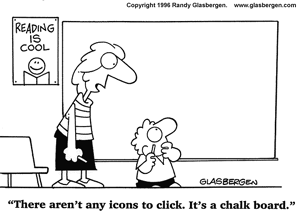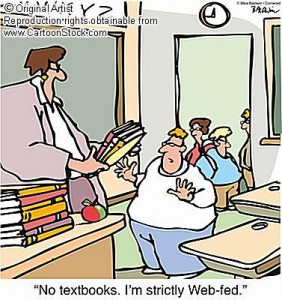I was born in 1974. It wasn’t until 1987 that my family got our first computer – I was thirteen. The internet didn’t start until the mid 1990’s – I had already graduated from high school by then. Current cell phone technology far exceeds those first generation computers that I experienced in my teens and twenties. Therefore, how can I, as a teacher, be expected to teach today’s students that have all grown up in the digital era with all this available technology? How can I teach someone that already knows more than I do?
An interesting thing happened to me this weekend. I was shopping with my wife and while waiting in line I happened to see a small child playing with her mother’s iPhone. She was manipulating pictures, viewing slideshows, listening to music, etc. (the line was long because of a sale so I was casually observing for a while). I finally had to ask the mother how old her child was – “she is 5”. I was floored! This five-year old knew how to use the iPhone better than most adults. This was even more unbelievable since my wife just got the new iPhone 4 two weeks ago and has little to no idea how to use it. It didn’t come with an owner’s manual as all the info (on how to use it) is stored in the phone or can be found on-line. As a teacher, the first thought that came to my head when I saw this little girl playing on her iPhone was, “poor kid… when she gets to school her teachers will have no idea how to keep her engaged”.
Then I thought of this course and my recent readings. This course started with the origins of orality and literacy and has progressed to digital literacy. At first, I personally found this course challenging because I had to work really hard to focus on the subject matter – I wasn’t feeling engaged. But, as we have shifted now to digital literacy my engagement and motivation has increased drastically. I find the current module intriguing because it highlights the current struggles that I feel the public education system faces in British Columbia.
 Today’s classroom couldn’t be more different than those of a generation past. Chalkboards and duotangs have been replaced by Interactive White Boards (IWB), tablets and laptops (to name a few). Owning a cell phone used to be a luxury – today they are part or every student’s arsenal. It would difficult to find a high school aged student that didn’t own either a cell phone, MP3 player and/or some version of a PDA device. “They have come of age in a digitally enhanced world and, consequently, their understanding of the world has come primarily from digital sources.” (Mabrito & Medley, 2008, p. 1) Most would agree that today’s students are more technologically inclined than their teachers. Unfortunately, many teachers are fearful of that they don’t understand; therefore these new technologies are seen as distractions. Wouldn’t it be nice if we could somehow use the devices to improve student engagement and learning?
Today’s classroom couldn’t be more different than those of a generation past. Chalkboards and duotangs have been replaced by Interactive White Boards (IWB), tablets and laptops (to name a few). Owning a cell phone used to be a luxury – today they are part or every student’s arsenal. It would difficult to find a high school aged student that didn’t own either a cell phone, MP3 player and/or some version of a PDA device. “They have come of age in a digitally enhanced world and, consequently, their understanding of the world has come primarily from digital sources.” (Mabrito & Medley, 2008, p. 1) Most would agree that today’s students are more technologically inclined than their teachers. Unfortunately, many teachers are fearful of that they don’t understand; therefore these new technologies are seen as distractions. Wouldn’t it be nice if we could somehow use the devices to improve student engagement and learning?
Engagement and learning are synonymous with education for a reason. It is nearly impossible for learning to transpire if students are void of motivation. Teachers are constantly faced with the challenge of motivating their students so that they will learn the concepts and theories that are being taught but how do they do that when they come from such a different place then the students they teach? Prensky (2001) argued that “our students have changed radically. Today’s students are no longer the people our educational system was designed to teach.” (p. 1) The chief reason for this, in my humble opinion, is technology. Prensky (2001) brought two terms into the discussion; digital natives and digital immigrants. Digital natives were described as those that are heavily immersed in technology and have been surrounded by it all their lives – those that were born in the digital era. Digital immigrants on the other hand are those that are new to technology and were born prior to the digital era and thus constantly trying to adapt and keep up with “the natives”. Today’s students are those natives and most teachers that have been entrusted with educating them are the immigrants. According to Prensky (and I agree) “the single biggest problem facing education today is that our Digital Immigrant instructors, who speak an outdated language (that of the pre-digital age), are struggling to teach a population that speaks an entirely new language.” (2001, p. 2)
So how do teachers narrow this “information processing gap” as Mabrito and Medley (2008) put it? I think the answer can be found in their 2008 article, Why Professor Johnny Can’t Read: Understanding the Net Generation’s Texts. They talk about the need for teachers, the fore-mentioned digital immigrants, to spend time in the same learning spaces as their students so they can get a better understanding of what they are experiencing. They “need to experience these learning spaces as learners before we can understand how to use them as teachers”. (p. 5) I couldn’t agree more! By doing this we can hopefully find new ways to present our lessons that will in turn engage our students in a more meaningful way.
(2008) put it? I think the answer can be found in their 2008 article, Why Professor Johnny Can’t Read: Understanding the Net Generation’s Texts. They talk about the need for teachers, the fore-mentioned digital immigrants, to spend time in the same learning spaces as their students so they can get a better understanding of what they are experiencing. They “need to experience these learning spaces as learners before we can understand how to use them as teachers”. (p. 5) I couldn’t agree more! By doing this we can hopefully find new ways to present our lessons that will in turn engage our students in a more meaningful way.
It is not merely a question of learning facts about the Net-Generation culture or how to operate the latest technology; faculty members need to focus more on attempting to experience the digital world in the same way that their students do. It is not enough for instructors to accept that learning may occur in these places; they must go there as well as scholars with information to share, as researchers attempting to gain insight, and, more importantly, as learners acquiring a new kind of understanding. (Mabrito & Medley, 2008, p. 5)
I am an electives teacher in high school and therefore I don’t have the luxury of guaranteed conscription in my courses. In order for full enrollment of my classes I have to make sure that I am not only providing my students a positive learning experience but one that also engages them in such a way that they are motivated to enroll in my course rather than some other. I don’t pretend to have the answers or know the solutions but what I have committed myself to do is to try new things. By introducing new experiences and opportunities, ones that more resemble the digital world they are familiar with, I am able to earn the respect of the students I teach. Even when I am unsuccessful in my attempts I know they appreciate my effort and my willingness to connect with them. If students today are so different then what is the point in trying to educate them with methods that they cannot relate to? Teaching is hard enough… there is no need to compound the challenge by using language and methodologies that are foreign to today’s students.
References:
Mabrito, M., Medley, R. (2008) Why professor johnny can’t read: Understanding the net generation’s texts. Innovate, 4(6), August/September. Retrieved November 10, 2010, from http://www.innovateonline.info/index.php?view=article&id=510&action=article
Prensky, M. (2001). Digital natives, digital immigrants. NCB University Press, 9(5), 1-6. Retrieved, November 18, 2010, from http://www.marcprensky.com/writing/Prensky%20-%20Digital%20Natives,%20Digital%20Immigrants%20-%20Part1.pdf
Prensky, M. (2005). Engage me or enrage me: What today’s learners demand. EDUCAUSE Review, 40(5), 61-65. Retrieved March 28, 2009, from http://net.educause.edu/ir/library/pdf/erm0553.pdf
Source for all three images: http://www.mcgilledus.ca/content/index.php?option=com_content&view=article&id=103&Itemid=70




Hi Ryan,
I love the cartoons you’ve included. They really drive home the advances in technology and how students are impacted by such changes. I wonder what cartoons on such issues will look like in 10 years from now.
Cathy